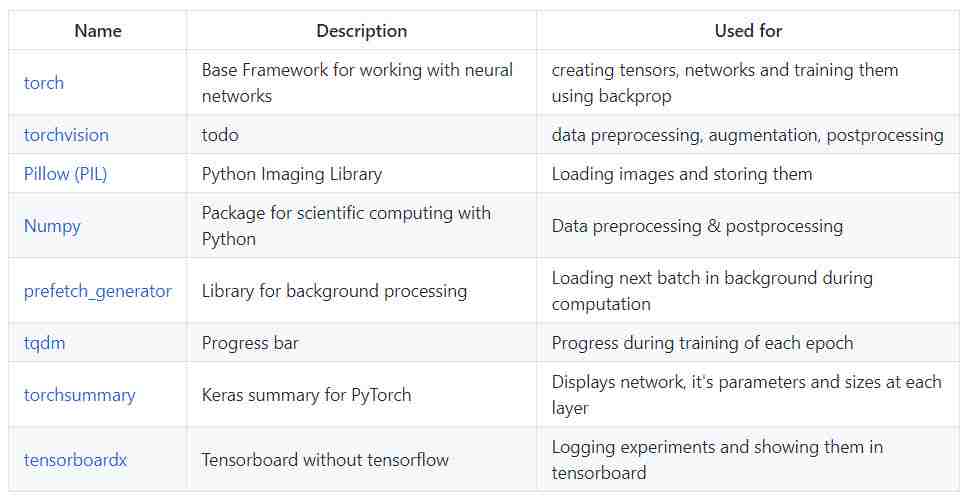PyTorch最佳实践,怎样才能写出一手风格优美的代码

选自github
机器之心编译
参与:Geek.ai、思源
虽然这是一个非官方的 PyTorch 指南,但本文总结了一年多使用 PyTorch 框架的经验,尤其是用它开发深度学习相关工作的最优解决方案。请注意,我们分享的经验大多是从研究和实践角度出发的。
这是一个开发的项目,欢迎其它读者改进该文档:https://github.com/IgorSusmelj/pytorch-styleguide。
本文档主要由三个部分构成:首先,本文会简要清点 Python 中的最好装备。接着,本文会介绍一些使用 PyTorch 的技巧和建议。最后,我们分享了一些使用其它框架的见解和经验,这些框架通常帮助我们改进工作流。
清点 Python 装备
建议使用 Python 3.6 以上版本
根据我们的经验,我们推荐使用 Python 3.6 以上的版本,因为它们具有以下特性,这些特性可以使我们很容易写出简洁的代码:
- 自 Python 3.6 以后支持「typing」模块
- 自 Python 3.6 以后支持格式化字符串(f string)
Python 风格指南
我们试图遵循 Google 的 Python 编程风格。请参阅 Google 提供的优秀的 python 编码风格指南:
地址:https://github.com/google/styleguide/blob/gh-pages/pyguide.md。
在这里,我们会给出一个最常用命名规范小结:

集成开发环境
一般来说,我们建议使用 visual studio 或 PyCharm 这样的集成开发环境。而 VS Code 在相对轻量级的编辑器中提供语法高亮和自动补全功能,PyCharm 则拥有许多用于处理远程集群任务的高级特性。
Jupyter Notebooks VS Python 脚本
一般来说,我们建议使用 Jupyter Notebook 进行初步的探索,或尝试新的模型和代码。如果你想在更大的数据集上训练该模型,就应该使用 Python 脚本,因为在更大的数据集上,复现性更加重要。
我们推荐你采取下面的工作流程:
- 在开始的阶段,使用 Jupyter Notebook
- 对数据和模型进行探索
- 在 notebook 的单元中构建你的类/方法
- 将代码移植到 Python 脚本中
- 在服务器上训练/部署

开发常备库
常用的程序库有:

文件组织
不要将所有的层和模型放在同一个文件中。最好的做法是将最终的网络分离到独立的文件(networks.py)中,并将层、损失函数以及各种操作保存在各自的文件中(layers.py,losses.py,ops.py)。最终得到的模型(由一个或多个网络组成)应该用该模型的名称命名(例如,yolov3.py,DCGAN.py),且引用各个模块。
主程序、单独的训练和测试脚本应该只需要导入带有模型名字的 Python 文件。
PyTorch 开发风格与技巧
我们建议将网络分解为更小的可复用的片段。一个 nn.Module 网络包含各种操作或其它构建模块。损失函数也是包含在 nn.Module 内,因此它们可以被直接整合到网络中。
继承 nn.Module 的类必须拥有一个「forward」方法,它实现了各个层或操作的前向传导。
一个 nn.module 可以通过「self.net(input)」处理输入数据。在这里直接使用了对象的「call()」方法将输入数据传递给模块。
output = self.net(input)PyTorch 环境下的一个简单网络
使用下面的模式可以实现具有单个输入和输出的简单网络:
classConvBlock(nn.Module):
def__init__(self):
super(ConvBlock, self).__init__()
block = [nn.Conv2d(...)]
block += [nn.ReLU()]
block += [nn.BatchNorm2d(...)]
self.block = nn.Sequential(*block)
defforward(self, x):
returnself.block(x)
classSimpleNetwork(nn.Module):
def__init__(self, num_resnet_blocks=6):
super(SimpleNetwork, self).__init__()
# here we add the individual layers
layers = [ConvBlock(...)]
for i in range(num_resnet_blocks):
layers += [ResBlock(...)]
self.net = nn.Sequential(*layers)
defforward(self, x):
returnself.net(x)请注意以下几点:
- 我们复用了简单的循环构建模块(如卷积块 ConvBlocks),它们由相同的循环模式(卷积、激活函数、归一化)组成,并装入独立的 nn.Module 中。
- 我们构建了一个所需要层的列表,并最终使用「nn.Sequential()」将所有层级组合到了一个模型中。我们在 list 对象前使用「*」操作来展开它。
- 在前向传导过程中,我们直接使用输入数据运行模型。
PyTorch 环境下的简单残差网络
classResnetBlock(nn.Module):
def__init__(self, dim, padding_type, norm_layer, use_dropout, use_bias):
super(ResnetBlock, self).__init__()
self.conv_block = self.build_conv_block(...)
defbuild_conv_block(self, ...):
conv_block = []
conv_block += [nn.Conv2d(...),
norm_layer(...),
nn.ReLU()]
ifuse_dropout:
conv_block += [nn.Dropout(...)]
conv_block += [nn.Conv2d(...),
norm_layer(...)]
return nn.Sequential(*conv_block)
defforward(self, x):
out = x + self.conv_block(x)
return ou在这里,ResNet 模块的跳跃连接直接在前向传导过程中实现了,PyTorch 允许在前向传导过程中进行动态操作。
PyTorch 环境下的带多个输出的网络
对于有多个输出的网络(例如使用一个预训练好的 VGG 网络构建感知损失),我们使用以下模式:
classVgg19(torch.nn.Module):
def__init__(self, requires_grad=False):
super(Vgg19, self).__init__()
vgg_pretrained_features = models.vgg19(pretrained=True).features
self.slice1 = torch.nn.Sequential()
self.slice2 = torch.nn.Sequential()
self.slice3 = torch.nn.Sequential()
for x in range(7):
self.slice1.add_module(str(x), vgg_pretrained_features[x])
for x in range(7, 21):
self.slice2.add_module(str(x), vgg_pretrained_features[x])
for x in range(21, 30):
self.slice3.add_module(str(x), vgg_pretrained_features[x])
ifnotrequires_grad:
for param inself.parameters():
param.requires_grad = False
defforward(self, x):
h_relu1 = self.slice1(x)
h_relu2 = self.slice2(h_relu1)
h_relu3 = self.slice3(h_relu2)
out = [h_relu1, h_relu2, h_relu3]
return out请注意以下几点:
- 我们使用由「torchvision」包提供的预训练模型
- 我们将一个网络切分成三个模块,每个模块由预训练模型中的层组成
- 我们通过设置「requires_grad = False」来固定网络权重
- 我们返回一个带有三个模块输出的 list
自定义损失函数
即使 PyTorch 已经具有了大量标准损失函数,你有时也可能需要创建自己的损失函数。为了做到这一点,你需要创建一个独立的「losses.py」文件,并且通过扩展「nn.Module」创建你的自定义损失函数:
classCustomLoss(torch.nn.Module):
def__init__(self):
super(CustomLoss,self).__init__()
defforward(self,x,y):
loss = torch.mean((x - y)**2)
return loss训练模型的最佳代码结构
对于训练的最佳代码结构,我们需要使用以下两种模式:
- 使用 prefetch_generator 中的 BackgroundGenerator 来加载下一个批量数据
- 使用 tqdm 监控训练过程,并展示计算效率,这能帮助我们找到数据加载流程中的瓶颈
# import statements
import torch
import torch.nn as nn
from torch.utils import data
...
# set flags / seeds
torch.backends.cudnn.benchmark = True
np.random.seed(1)
torch.manual_seed(1)
torch.cuda.manual_seed(1)
...
# Start with main code
if __name__ == '__main__':
# argparse for additional flags for experiment
parser = argparse.ArgumentParser(description="Train a network for ...")
...
opt = parser.parse_args()
# add code for datasets (we always use train and validation/ test set)
data_transforms = transforms.Compose([
transforms.Resize((opt.img_size, opt.img_size)),
transforms.RandomHorizontalFlip(),
transforms.ToTensor(),
transforms.Normalize((0.5, 0.5, 0.5), (0.5, 0.5, 0.5))
])
train_dataset = datasets.ImageFolder(
root=os.path.join(opt.path_to_data, "train"),
transform=data_transforms)
train_data_loader = data.DataLoader(train_dataset, ...)
test_dataset = datasets.ImageFolder(
root=os.path.join(opt.path_to_data, "test"),
transform=data_transforms)
test_data_loader = data.DataLoader(test_dataset ...)
...
# instantiate network (which has been imported from *networks.py*)
net = MyNetwork(...)
...
# create losses (criterion in pytorch)
criterion_L1 = torch.nn.L1Loss()
...
# if running on GPU and we want to use cuda move model there
use_cuda = torch.cuda.is_available()
if use_cuda:
net = net.cuda()
...
# create optimizers
optim = torch.optim.Adam(net.parameters(), lr=opt.lr)
...
# load checkpoint if needed/ wanted
start_n_iter = 0
start_epoch = 0
if opt.resume:
ckpt = load_checkpoint(opt.path_to_checkpoint) # custom method for loading last checkpoint
net.load_state_dict(ckpt['net'])
start_epoch = ckpt['epoch']
start_n_iter = ckpt['n_iter']
optim.load_state_dict(ckpt['optim'])
print("last checkpoint restored")
...
# if we want to run experiment on multiple GPUs we move the models there
net = torch.nn.DataParallel(net)
...
# typically we use tensorboardX to keep track of experiments
writer = SummaryWriter(...)
# now we start the main loop
n_iter = start_n_iter
for epoch in range(start_epoch, opt.epochs):
# set models to train mode
net.train()
...
# use prefetch_generator and tqdm for iterating through data
pbar = tqdm(enumerate(BackgroundGenerator(train_data_loader, ...)),
total=len(train_data_loader))
start_time = time.time()
# for loop going through dataset
for i, data in pbar:
# data preparation
img, label = data
if use_cuda:
img = img.cuda()
label = label.cuda()
...
# It's very good practice to keep track of preparation time and computation time using tqdm to find any issues in your dataloader
prepare_time = start_time-time.time()
# forward and backward pass
optim.zero_grad()
...
loss.backward()
optim.step()
...
# udpate tensorboardX
writer.add_scalar(..., n_iter)
...
# compute computation time and *compute_efficiency*
process_time = start_time-time.time()-prepare_time
pbar.set_description("Compute efficiency: {:.2f}, epoch: {}/{}:".format(
process_time/(process_time+prepare_time), epoch, opt.epochs))
start_time = time.time()
# maybe do a test pass every x epochs
if epoch % x == x-1:
# bring models to evaluation mode
net.eval()
...
#do some tests
pbar = tqdm(enumerate(BackgroundGenerator(test_data_loader, ...)),
total=len(test_data_loader))
for i, data in pbar:
...
# save checkpoint if needed
...PyTorch 的多 GPU 训练
PyTorch 中有两种使用多 GPU 进行训练的模式。
根据我们的经验,这两种模式都是有效的。然而,第一种方法得到的结果更好、需要的代码更少。由于第二种方法中的 GPU 间的通信更少,似乎具有轻微的性能优势。
对每个网络输入的 batch 进行切分
最常见的一种做法是直接将所有网络的输入切分为不同的批量数据,并分配给各个 GPU。
这样一来,在 1 个 GPU 上运行批量大小为 64 的模型,在 2 个 GPU 上运行时,每个 batch 的大小就变成了 32。这个过程可以使用「nn.DataParallel(model)」包装器自动完成。
将所有网络打包到一个超级网络中,并对输入 batch 进行切分
这种模式不太常用。下面的代码仓库向大家展示了 Nvidia 实现的 pix2pixHD,它有这种方法的实现。
地址:https://github.com/NVIDIA/pix2pixHD
PyTorch 中该做和不该做的
在「nn.Module」的「forward」方法中避免使用 Numpy 代码
Numpy 是在 CPU 上运行的,它比 torch 的代码运行得要慢一些。由于 torch 的开发思路与 numpy 相似,所以大多数 Numpy 中的函数已经在 PyTorch 中得到了支持。
将「DataLoader」从主程序的代码中分离
载入数据的工作流程应该独立于你的主训练程序代码。PyTorch 使用「background」进程更加高效地载入数据,而不会干扰到主训练进程。
不要在每一步中都记录结果
通常而言,我们要训练我们的模型好几千步。因此,为了减小计算开销,每隔 n 步对损失和其它的计算结果进行记录就足够了。尤其是,在训练过程中将中间结果保存成图像,这种开销是非常大的。
使用命令行参数
使用命令行参数设置代码执行时使用的参数(batch 的大小、学习率等)非常方便。一个简单的实验参数跟踪方法,即直接把从「parse_args」接收到的字典(dict 数据)打印出来:
# saves arguments to config.txt file
opt = parser.parse_args()with open("config.txt", "w") as f:
f.write(opt.__str__())如果可能的话,请使用「Use .detach()」从计算图中释放张量
为了实现自动微分,PyTorch 会跟踪所有涉及张量的操作。请使用「.detach()」来防止记录不必要的操作。
使用「.item()」打印出标量张量
你可以直接打印变量。然而,我们建议你使用「variable.detach()」或「variable.item()」。在早期版本的 PyTorch(< 0.4)中,你必须使用「.data」访问变量中的张量值。
使用「call」方法代替「nn.Module」中的「forward」方法
这两种方式并不完全相同,正如下面的 GitHub 问题单所指出的:https://github.com/IgorSusmelj/pytorch-styleguide/issues/3 

output = self.net.forward(input)
# they are not equal!
output = self.net(input)原文链接:https://github.com/IgorSusmelj/pytorch-styleguide
本文由机器之心编译,转载请联系本公众号获得授权。
✄------------------------------------------------
加入机器之心(全职记者 / 实习生):[email protected]
投稿或寻求报道:content@jiqizhixin.com
广告 & 商务合作:[email protected]
阅读原文 最新评论
推荐文章
作者最新文章
你可能感兴趣的文章
Copyright Disclaimer: The copyright of contents (including texts, images, videos and audios) posted above belong to the User who shared or the third-party website which the User shared from. If you found your copyright have been infringed, please send a DMCA takedown notice to [email protected]. For more detail of the source, please click on the button "Read Original Post" below. For other communications, please send to [email protected].
版权声明:以上内容为用户推荐收藏至CareerEngine平台,其内容(含文字、图片、视频、音频等)及知识版权均属用户或用户转发自的第三方网站,如涉嫌侵权,请通知[email protected]进行信息删除。如需查看信息来源,请点击“查看原文”。如需洽谈其它事宜,请联系[email protected]。
版权声明:以上内容为用户推荐收藏至CareerEngine平台,其内容(含文字、图片、视频、音频等)及知识版权均属用户或用户转发自的第三方网站,如涉嫌侵权,请通知[email protected]进行信息删除。如需查看信息来源,请点击“查看原文”。如需洽谈其它事宜,请联系[email protected]。